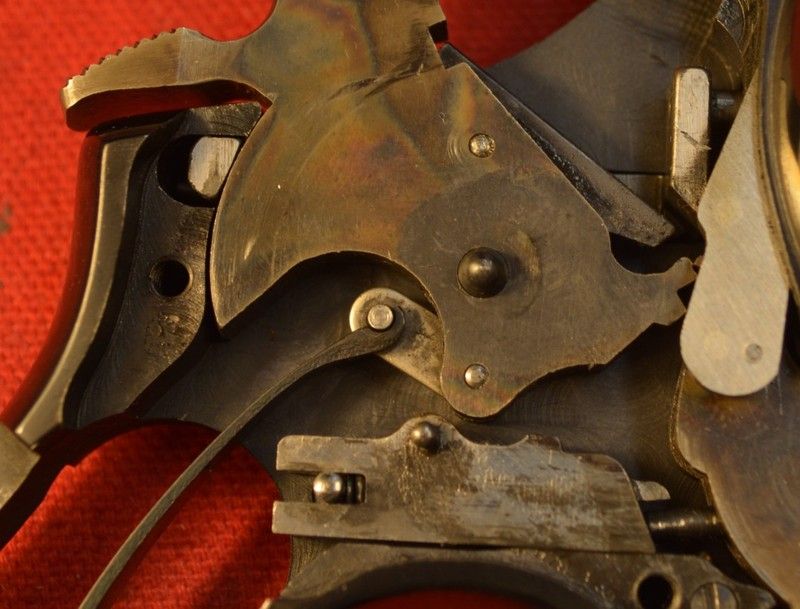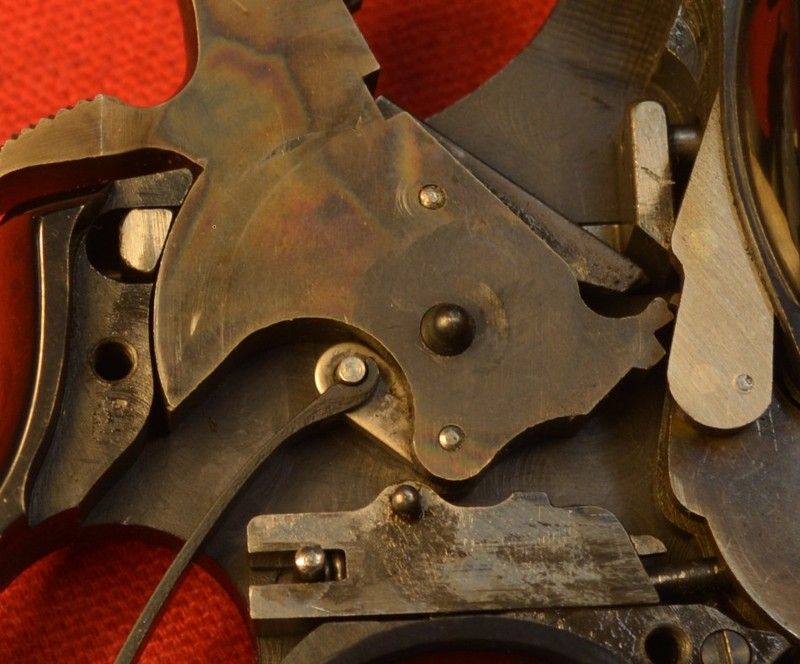Howdy
Shooters have been backing out the strain screw on Smith and Wesson revolvers to lighten the trigger pull for over 100 years. GENERALLY SPEAKING, it will not damage anything.
HOWEVER..................if you back the screw out too far, it will cause a problem. Back the screw out enough and you will notice the hammer suddenly becomes much
more difficult to cock.
When the strain screw is torqued all the way in, it affects the shape of the spring. Back it out a bit, and the bent shape of the spring changes slightly. Back it out too much and there is a problem.
This is a view of the hammer fully cocked with the strain screw torqued all the way in. The piece the spring is hooked under is called the stirrup. The stirrup is pinned to the hammer, and swings through a slot in the hammer to engage the mainspring in all aspects of rotation.
In this photo I have backed the strain screw out too far. I am encountering resistance to the hammer going back all the way to full cock. What is happening is the new curve the spring took is forcing the stirrup to pivot too far. You can see the change in the angle. The stirrup has swung as far as the slot in the hammer will allow, and now it is binding against the body of the hammer.
It just so happens the revolver I used for these photos is a Model 19-3 made in 1975. But this will happen with any S&W revolver made with traditional forged and machined parts. What really surprised me was it only took backing the strain screw out two full turns to get the hammer to bind up like this. If I backed it out much more, it would probably damage something, most likely damaging the stirrup by putting too much pressure on it. I did not try backing the screw out any more to see.
Backing the strain screw out enough to bind up the stirrup this way will vary from revolver to revolver, mostly depending on how deep the slot is in the hammer. But I was quite surprised that it only took two full turns on this Model 19 to get the hammer to bind up.
I have not tried this with a S&W revolver made with MIM parts. I do know that the MIM hammer and trigger have been substantially redesigned from the earlier forged and machined parts. I do not know if this phenomenon of binding up the stirrup on a MIM hammer will happen or not.
An experiment for another day.
With any revolver, either single action or double action, when the hammer is cocked in single action mode, the hammer spring forces the cocking notch of the hammer hard against the sear with a certain amount of force. When the trigger is pulled, the force against the sear causes friction as the sear slides out of the notch. This friction is in addition to the force required to overcome the rebound slide spring. By lightening the hammer spring, you are reducing that amount of friction so it requires less force on the trigger to slide the sear out of the notch. That is why backing out the strain screw on a S&W revolver affects the single action trigger pull.
The old trick with a Colt Single Action Army was to place a leather spacer between the hammer spring and the frame, effectively reducing the force the hammer spring exerted on the hammer. I have reduced the trigger pull in Colts to 2 1/2 pounds by simply grinding down the hammer spring, without doing anything else.
In double action mode there are two springs that affect trigger pull in a S&W revolver. The hammer spring or main spring, and the rebound slide spring. Competition shooters have known for many years that they can lighten the double action trigger pull by grinding the rebound slide spring shorter. You can try clipping it, but the spring is pretty tough. Competition shooters also know that by lightening the rebound slide spring, the trigger will not return as crisply after every double action shot. So there is a balance that must be struck.
You can try filing the hammer spring, but you will be there all day and you will accomplish nothing. The spring steel of the hammer spring is much too tough and a file will not touch it. To lighten the hammer spring you have to grind it. And yes, it is very easy to screw up and ruin the spring.
I absolutely recommend against messing with the engagement of the single action sear in a S&W revolver and the trigger. Do not even think about it unless you know exactly what you are doing. You could make the gun unsafe very easily.
If you want to buy springs from Wolff, you can buy a kit that includes a reduced power hammer spring, and three reduced power rebound slide springs, so you can fine tune the trigger pull.
Of course replacing the rebound spring in a S&W revolver is the trickiest part of putting the gun back together again, but if the OP successfully reassembled his Model 19, he should be able to replace the rebound slide spring without launching it across the basement to hide in the most inaccessible spot in the room. Don't ask me how I know about this.
There is a tool you can buy from Brownells that makes changing the rebound slide spring a little bit easier.


